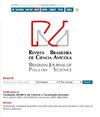Reproduction factor of Meloidogyne javanica, M. incognita and Pratylenchus brachyurus in sorghum, millet and sunflower varieties
IF 1.1
4区 农林科学
Q3 AGRICULTURE, DAIRY & ANIMAL SCIENCE
引用次数: 0
Abstract
The use of agricultural species resistant to root-knotting and root-wounding nematodes, in crop rotation systems, keeps the nematode population at low levels, reducing losses and enabling the planting of more susceptible species. In this study, the resistance of sorghum, millet and sunflower genotypes to root-knot nematodes Meloidogyne javanica, M. incognita and Pratylenchus brachyurus was evaluated. The tests were conducted in a greenhouse and the genotypes sown in plastic pots containing 2 L of sterilized substrate and inoculated with 1,600 nematode eggs and juveniles per pot, arranged in a completely randomized design with nine replications. The evaluation of nematode reproduction was performed by counting the number of juveniles/adults per root system and soil, calculating the Reproduction Factor (FR = Pf/Pi). According to the results, all sorghum, millet and sunflower genotypes behaved as resistant to the reproduction of M. javanica, M. incognita and P. brachyurus. Commercial resistant genotypes are indicated for use in rotation of areas infested by these nematodes.高粱、谷子和葵花品种爪哇花栗鼠、无头花栗鼠和短尾花栗鼠的繁殖因子
在作物轮作系统中使用对结根线虫和伤根线虫具有抗性的农业品种,可使线虫种群保持在较低水平,减少损失并使种植更易感的品种成为可能。研究了高粱、谷子和向日葵基因型对javanmeloidogyne、M. incognita和Pratylenchus brachyurus根结线虫的抗性。试验在温室中进行,基因型播种在塑料罐中,罐中有2 L灭菌底物,每罐接种1600个线虫卵和幼虫,采用完全随机设计,9个重复。通过计算每个根系和土壤的幼虫/成虫数量,计算繁殖系数(FR = Pf/Pi)来评价线虫的繁殖能力。结果表明,所有高粱、谷子和向日葵基因型均对爪哇栗鼠、无头栗鼠和短尾栗鼠的繁殖表现出抗性。商业耐药基因型可用于这些线虫感染地区的轮作。
本文章由计算机程序翻译,如有差异,请以英文原文为准。
求助全文
约1分钟内获得全文
求助全文
来源期刊

Brazilian Journal of Poultry Science
农林科学-奶制品与动物科学
CiteScore
1.80
自引率
9.10%
发文量
60
审稿时长
>12 weeks
期刊介绍:
A Revista Brasileira de Ciência Avícola surgiu em 1999 a partir da necessidade que a comunidade científica possuía de um periódico para veiculação e publicação de seus trabalhos, com a publicação de três números anuais.
A Revista conta hoje com um corpo editorial altamente qualificado e com artigos científicos desenvolvidos pelos maiores especialistas da área, o que a cada dia atrai mais leitores em busca de inovação e respaldo técnico.
Devido à credibilidade que conquistou pelos esforços de sus autores, relatores e revisores, a Revista ganhou caráter de coleção, sendo consultada como fonte segura de estudo desenvolvidos na Avicultura.
A partir de 2003 – volume 5 -, a Revista passou a chamar-se Brazilian Journal of Poultry Science, e todos os trabalhos passaram a ser publicados em inglês. No mesmo ano subiu para quatro o número de revistas por volume, ampliando-se assim os trabalhos publicados anualmente.
 求助内容:
求助内容: 应助结果提醒方式:
应助结果提醒方式:


